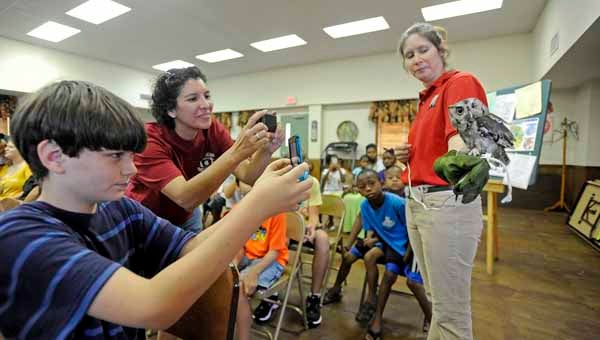Feathered Friends
Published 11:00 pm Thursday, June 13, 2013

Representatives from the Montgomery Zoo presented various birds of prey as part of the summer reading program at the Tupper Lightfoot Memorial Library in Brundidge Thursday. Jesse Nicholson and Alette Hatfield take photographs as Jennifer Hutcheson presents a Screech Owl.
Montgomery Zoo birds of prey visit Brundidge summer reading program
Children who are participating in the Tupper Lightfoot Memorial Library’s summer reading program are usually digging into reading. But not Thursday afternoon. Instead, they were flapping about reading.
A large number of summer reading program participants and others, who just wanted to know more about birds, gathered at Brundidge Station for a bird presentation sponsored by the Montgomery Zoo.
Jennifer Hutcheson, the zoo’s education curator, spoke about the birds as they were each coaxed out of their cages for an up-close-and-personal view.
The Montgomery Zoo’s “show and tell” birds included a Harris Hawk, a black vulture, a screech owl, a barred owl and the star of the show, Aspen the Golden Eagle.
The 19-year-old golden eagle wowed more than just the Auburn fans.
The young readers at the program were invited to guess the weight of the eagle and guesses started at 100 pounds.
“Not that much,” Hutcheson said, time after time. When the guess was down to 20 pounds, there was a slow countdown to 12 pounds. The youngsters were amazed that a bird so big could weigh so little.
“The eagle’s bones are hollow, so its only real weight is its feathers,” Hutcheson said.
She further amazed the readers when she told them that an eagle, on a downward flight, could reach 95 miles per hour.
“A golden eagle could knock a mountain goat off the mountain by flying into it with its breast,” she said. “The goat would be injured and food for the eagle.”
Hutcheson told the program participants that vultures are nature’s garbage collectors. She explained what the world would be like if there were no vultures to devour the road kills and other decaying animals in the woodlands.
The vultures that live in zoos are feed what looks like raw hamburger meat that has nutrients added to keep the vultures happy.
“These vultures are imprinted,” she said.
“That means they were raised by humans. They don’t know about eating dead and decaying animals. So they like what they are fed.”
Hutcheson explained that the zoo is able to keep animals to use in educational programs only if they are imprinted or have a physical or mental condition that would keep them from being able to survive in the wild.
Jennifer Amlong, children’s librarian at the Tupper Lightfoot Memorial Library, expressed appreciation to the Montgomery Zoo for providing such an interesting and informative program for the children.
“We have an exciting summer program planned and encourage parents to visit the library with their children to find out more about programs of interest to them,” Amlong said.




